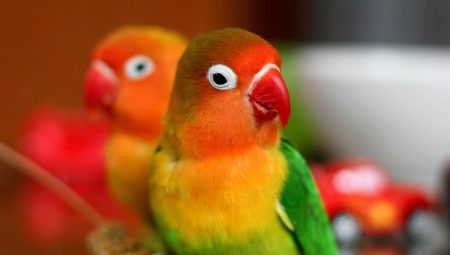Parrots are just those birds that many people want to breed. But before you do this, you need to thoroughly deal with their specific varieties. In this article, we will understand what parrots are lovebirds.

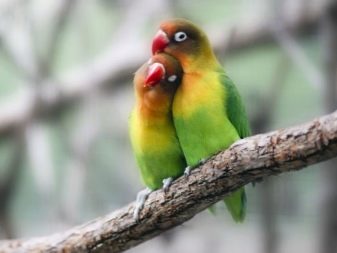
Description
This genus is a member of the parrot family of parrot birds. Lovebirds in length reach 0.1-0.17 m. The wingspan is 0.04 m, the tail extends 0.06 m. The weight of the bird is from 0.04 to 0.06 kg. The head is relatively large.
Most often, the feather is green. However, single sections (nails, breast, head and neck) can be painted in different tones. It occurs:
- red;
- blue
- yellow;
- pink and other colors.
The beak of the lovebird parrot is very thick and powerfully bent, characterized by great strength. Because bird bites can cause serious injury even to adults.
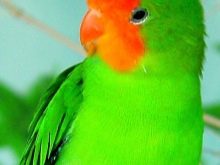
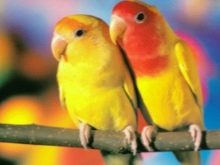
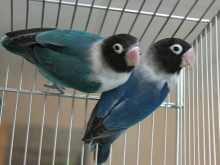
The beak itself is colored either bright red or straw yellow. The tail is not too long, as are the legs. This does not interfere, however, the parrot quickly move on the ground and even climb trees.
Lovebirds live in the forests of the tropics and subtropics; there are also species that inhabit the steppe and mountainous terrain. A flocking way of life is characteristic of them. The flight of these parrots is very fast and stable. At night, birds sit on tree branches, or cling to small knots. There are mentions that different flocks can enter the struggle for already occupied trees.
According to some reports, the homeland of the lovebirds is South-West and Southeast Africa, Madagascar. Nesting occurs in hollows. There, the birds only spread the litter.But occasionally lovebirds are engaged in the construction of nests. The construction is very effective.
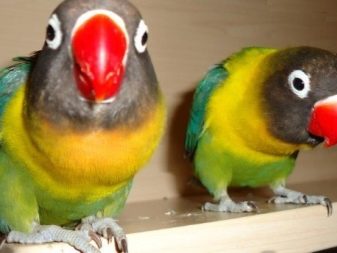
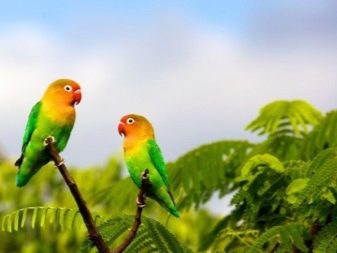
To build a nest, birds need:
- small twigs;
- blades of grass;
- fragments of the cortex.
It is curious that different species in this genus can carry the assembled building material in different ways. Someone wears it in its beaks, and someone flies, delivering the same branches under the feathers. Clutch is 4-8 eggs. Hatching time is 21-25 days. The name "lovebirds" is associated with the notion that in the event of the death of one of a pair of birds, the second will soon die.
But this is more of a myth, you just need some time before a new family appears. The flocks are relatively small, each comprising several couples. Very often, lovebird parrots are drawn to farms that provide them with food. Birds feed on seeds and berries.
The ratio of lovebirds to other species of birds is very aggressive.
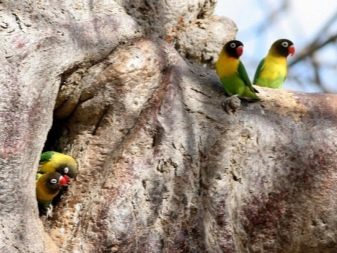

Kinds
Rosy cheek
A pink-cheeked lovebird reaches 0.17 m in length, while its wing grows to 0.1 m. The tonality of such a parrot is very elegant, contains rich green tones. The back has a slight blue tint.. The name of the species is due to the fact that the cheeks, as well as the throat, are pink. Saturated red forehead and beak of yellow straw color look very attractive.
The steering feathers in the middle are painted green. On the sides they are red, include wide black stripes. The tail feathers are painted in bright blue. Young chicks have a brownish-black beak, only its tip is lighter. At the same time, young animals have no red tones.
In nature, lovebirds are often found in Namibia, Angola and the Republic of South Africa. Although birds inhabit dry areas, they tend to seek water sources. In some cases, lovebirds settle in the walls of huts or under the roof. The pink-cheeked look is more popular than others among breeders.
Most often they are kept in pairs. But at the same time, if you keep pink-cheeked lovebirds one by one, they talk much more often.
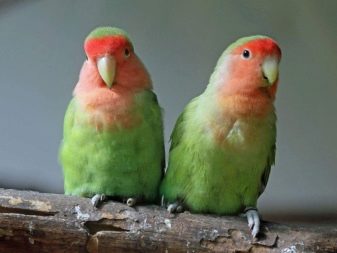

Fisher
Quite popular is the view of Fisher. Such lovebirds are cheerful and energetic, while special difficulties in content are excluded. Fischer's parrot is slightly smaller than the pink-cheeked one - up to 0.15 m. At the same time, its wings grow to 0.2 m. The species got its name in honor of the German explorer of Africa. Since breeders are actively working with Fishers, these birds have an impressive palette of feathers. And the natural color of the pen is very elegant. The parrot is smart and even looks like a Christmas tree toy. The backs, stomachs and short tails have a green color, diluted with bluish notes.
Neck and head are orange with a reddish tint. The plumage of the chest of lemon color. Expressive black eyes are surrounded by white skin. Strong red beaks have a scarlet surface. The paws are relatively short and end with slightly blue fingers.
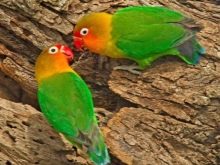
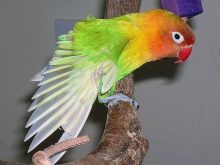
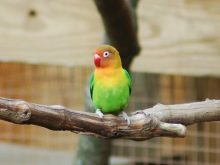
Fisher’s lovebirds inhabit the savannas of northern Tanzania. Near the shores of Lake Victoria, they settled in firmly, even adapted to the change of dry and wet seasons. The abundance of grasses and low shrubs provides extensive material for both nutrition and the construction of nests. Small parrots are grouped in flocks and only during breeding settle in pairs.
Fisher’s lovemaking family alliances are enviable. Nests are built on trees or in rocky terrain. Over the past 80 years, European ornithologists and breeders have managed to gain a fair amount of experience growing these parrots in captivity.
In an ordinary city apartment, they live quietly. However, like red-cheeked animals, they cannot tolerate any other species of bird - so here you have to make a choice.

Masked
Masked lovebirds deserve attention. They look very pretty. Most often, the bird does not exceed 0.15 m in length. The tail accounts for 0.04 m. The wings of this species are up to 0.05 m in length. The mass of an adult masked lovebird can reach 0.05 kg.The name of the species is given for the characteristic "mask". Large brown eyes are surrounded by dark feathers. The plumage of the masked species of birds is painted in bright colors, among which green dominates. In combination with the rest of the yellow feathers, a very attractive look is obtained.
Saturated red beak helps to complete the image. Thanks to him, a bird may seem as motley as a rainbow. When kept in a cell, a masked lovebird will be able to live 10-12 years. Occasionally, older specimens are also found. In nature, the species inhabits Kenya and Tanzania, forming flocks of several dozen individuals. There, birds settle near water bodies and nest on low trees, on bushes.
The main food is local cereals and fruits. The melodies produced by the mask lovebird very clearly reflect their mood. The disadvantage of this type is the difficulty of training and training. Only loners can be taught something, but they will have to be dealt with from the very first days. To some extent, learning is facilitated by a fairly high intelligence and excellent memory.
If a certain bird does not study well, it is not stupid, but simply wayward.
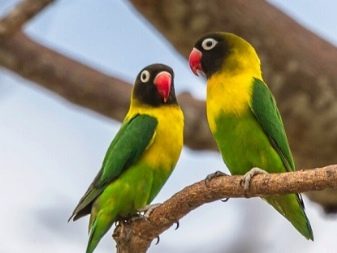

Black cheek
It is useful to characterize the black-cheeked lovebird. In appearance, it looks like a Fisher. However, the bird is slightly smaller. The difference is that black-skinned parrots have an orange-red collar. Feathers on the head are painted in a light gray tone.
By musicality, this bird is the most musical among its kind. But now she is threatened with extinction.
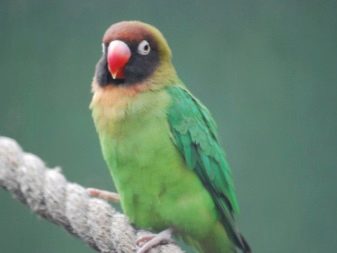
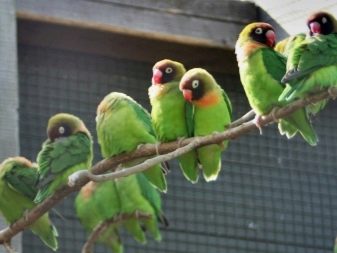
Liliana
The lovebird of Liliana, who is also a strawberry-headed one, is extremely rare, since his removal from places of permanent residence is prohibited. You can distinguish this species from the Fisher parrot by its green tint. The color of ripe strawberries is characteristic of the forehead, cheeks and throat. The rest of the head and chest are light green; the beak is colored in red. Dimorphism is not traced. Liliana's lovebird is very easy to get divorced and can adapt to a variety of conditions.
Those who do not need to acquire a well-speaking bird can purchase the black-winged lovebird. But the color of this species is not very attractive. In addition, birds can only be exported to Europe with strict restrictions. The green bird has black stripes above the wings and on the edge of the tail. The tail end is colored green.
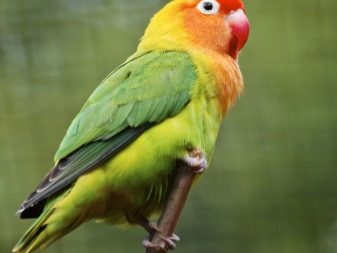
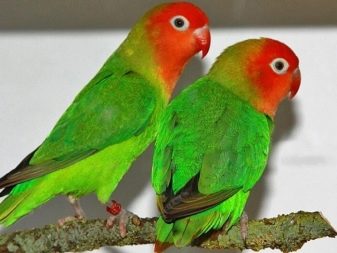
Red-faced
The red-faced, he is orange-headed, the parrot has the color of a tone of green grass. In this case, not only the cheeks and forehead, but even the neck turn out to be red. The ultramarine tails look amazing. These birds, with a black inner wing, love warmth. In nature, they inhabit termite mounds, which is very unusual.
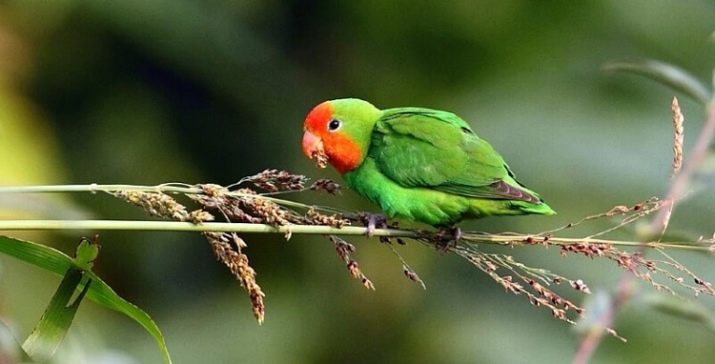
Gray-headed
A gray-headed lovebird living in Madagascar is characterized by powerful dimorphism. The species is considered the smallest in the entire family. The plumage is rather pale. Parrots are quite calm, differ even in some timidity. At the same time, cold and humidity are very poorly reflected in birds.
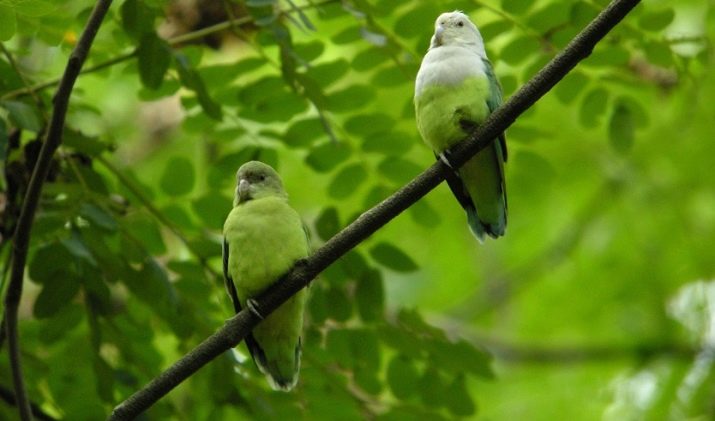
Can a parrot live alone?
This question is connected with the popular myth that it is unacceptable to separate the formed pair of parrots. They say that this will lead to the death of birds from longing. Even the name of the genus seems to be symptomatic. However, in fact, if you separate these parrots, they will live quite normal. And even with initial solitude, the lovebird lives well.
But you can’t leave the bird without control. The approach to singles should be different than to couples. Single parrots require increased attention. During the first week, the individual will adapt to the changing environment.
Not only furniture and the configuration of the premises, but even sounds, smells can affect the parrot badly.
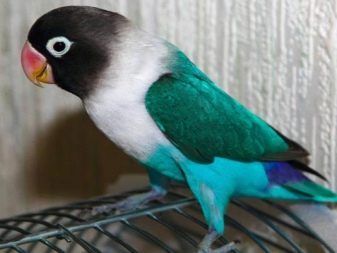
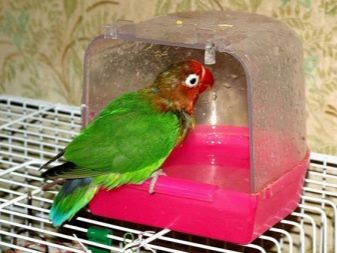
Do not think that after adaptation, it is enough to feed the bird and talk with it. Have to communicate more actively. One needs to play with lonely lovebirds - both in the cage and in free flight. If the parrot will constantly live in a cage, then he will not be able to fully develop. For him, regular exercise is also important.
To eliminate boredom, when the owners can not deal with a lovebird, they use special toys:
- small bells;
- rustles;
- stairs
- ropes.
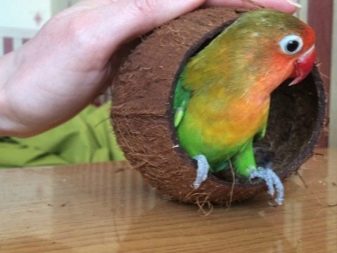
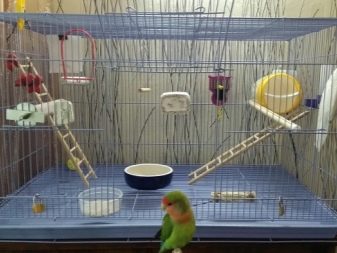
If a lovebird becomes an “orphan” forcibly, after the death or other loss of a partner, he may:
- fall into apathy;
- to be sad;
- pluck feathers.
Sometimes the output is a pair change. The main thing is that she was not the same gender. It happens that the second lovebird does not help. In this case, the urgent help of a veterinarian is required. He must examine both birds.
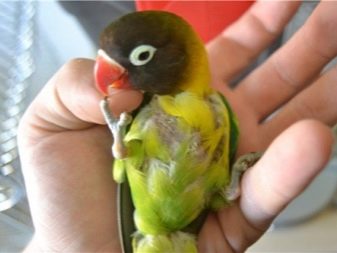
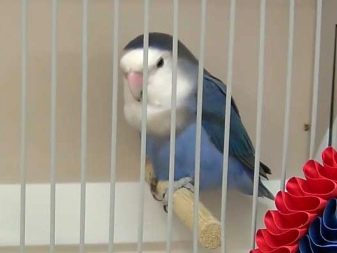
When one of a pair of birds dies from any disease (especially infectious), the second must be examined. And in case of death from an accident, the remaining bird should be given maximum care and attention. Try to communicate more with a parrot. They give him unexpected bright gifts and favorite goodies. When the owner is in the room, he must keep the cage open - the parrot may want to go for a walk.
It is useful to equip a new play area. When the owner leaves the room, he must carefully, without violence, drive the parrot into the cage. The door must be closed. To make things easier, use refreshments.
When such measures fail, you should still try to create a full-fledged pair (this is an ideal way out).
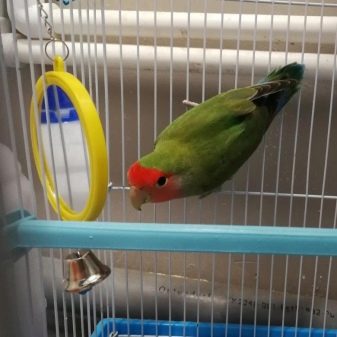
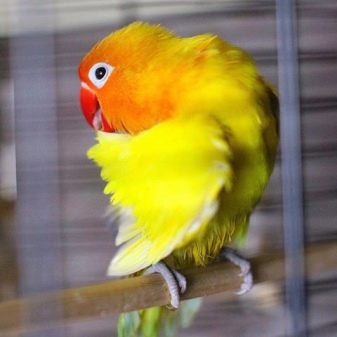
How to tame your hands?
Immediately disappoint: the full taming of lovebirds in the sense that they execute commands, like a trained dog or cat, is impossible. But it is quite possible to wean biting - if you find the right approach. Taming in a more serious form is only possible for single individuals, especially if started from an early age. Breaking established stereotypes of behavior in birds is very difficult. If a couple of birds live, then they will pay almost all attention to each other, and they will pay attention to a person by the residual principle.
Taming lovebirds takes a lot of time and at first it may seem that there are no results at all. First you need to cope with the natural fear of the animal in relation to humans. Only after complete addiction, being at rest, he will fully communicate with the owner. It is unacceptable to force contact in the first few days after buying a new individual!
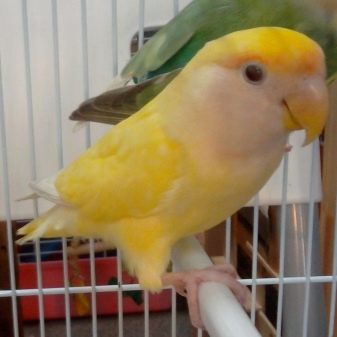
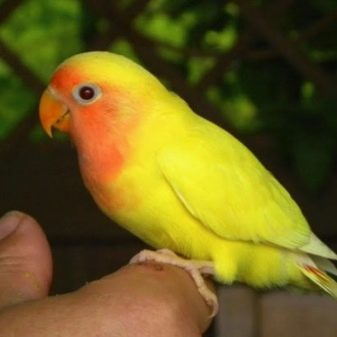
The fact is that at that time she was already adapting to a dramatically changing environment. Attempts to get closer and communicate can be perceived as a serious, moreover, obscure, threat. In the future, there is practically no chance to cope with such a reaction. During adaptation, contact with the bird should be limited only to the necessary care. At other times, you can’t enter the room again.
Be sure to close the door and exclude the appearance of noise. Some lovebirds are so shocked by the move that they are even afraid to use an unusual feeding trough. Then a certain amount of food is simply poured into the bottom of the cell. This will allow, along with nutrition, to begin to establish contact. No one will name the exact dates, how many days or hours the adaptation continues.
You need to carefully look at the reaction of the bird. The first sign that the parrot trusts the owners is its complete calm when they appear. To speed up the process, the animal is fed in modest portions every 3-4 hours.
Conversations with a lovebird must begin in a low voice, with a benevolent intonation. Ideally, you should also communicate with him further.
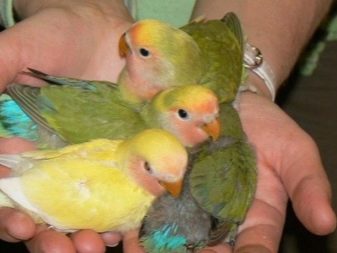
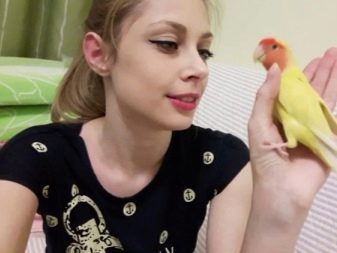
Gradually for taming, they begin to be more and more often near the cage. Best immediately after bookmarking food. In this case, sweeping movements and loud sounds are unacceptable. Noticing that the lovebird began to live quietly, ignoring cleaning or feeding, you can try to deepen the contact. Important helpers are toys and small pieces of delicious food.
Toys twist around the cage. Favorite food of a parrot is pushed through the bars. You can only turn your hand inside if the bird has paid attention to the bait. Categorically it is impossible, at any degree of contact, to encroach on bird territory. This can be perceived as aggression, and an attack will follow.
As soon as the slightest displeasure, irritation is noticed, it is better to remove your hands from the cage. A second attempt should be made only after 2-3 days. When the bird still has fresh memories of what happened, a new contact can only provoke the consolidation of the conditioned reflex.
Each time it is advised to offer the parrot new items; the pinnacle of success is when he sits on an empty hand.
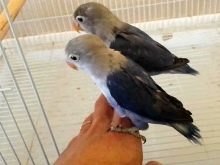
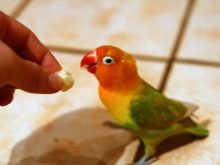
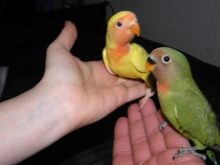
How to determine gender and age?
Knowing how to distinguish a female from a male, how to determine the number of years of an individual, is very important when buying lovebirds. Any one sign may turn out to be little informative and even deceptive. It is advisable to observe the bird for some time in captivity. The need to distinguish a boy from a girl arises even for those who intend to contain only one bird. Later it will be impossible to retrain her from one nickname to another; at best, it will require a lot of time and effort.
In addition, placing parrots homogeneous across the floor in the cage will have to suffer all the time from their quarrels and screams. Typically, in "women" the body is larger than in "men". Also they have:
- less flat top of head;
- forehead is higher;
- less angular nape;
- the head as a whole is closer to the shape of the dome and somewhat smaller.
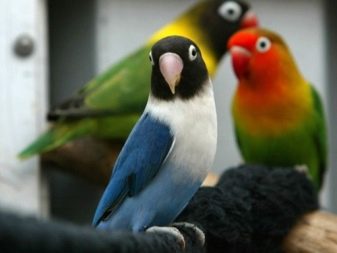

The male beak is paler than the female and has a mild central groove. In this case, an closer clue is the closer arrangement of the paws. A big problem in assessing the sex and age of a wild lovebird is its aggressiveness. At home, the bird is shown to veterinarians. When buying, they are sent to safe places, and ideally, they go there with a veterinarian or an expert.
The largest monthly lovebird is not inferior to adults and even old individuals. One must look at the skin above the beak near the nostrils. In the first three months it is dark, and later brightens. An important tip in determining age is the color of the pen. It is only necessary to take into account the features of a particular type. In general, an old individual can be recognized by:
- relatively small pupil;
- darkening of the paws;
- an increase in the number of scales on them;
- an increase and thickening of the beak;
- sometimes by peeling it off.
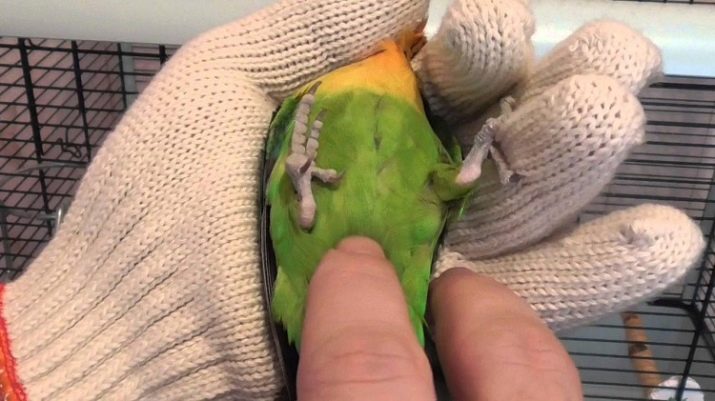
How to teach to talk?
Getting a parrot at home, many expect that the bird will talk. We must immediately consider that lovebird is significantly inferior in talkativeness and clarity of speech not only to cockatoo, but also to budgies. It is impossible to get them to pronounce phrases, sentences. What is quite possible to achieve is that the birds can give their names. It should also be taken into account that the lovebird's voice has a high frequency, and its timbre is very sharp.
Success is achieved only:
- in a spacious cage;
- with good nutrition;
- subject to systematic communication with the owners.
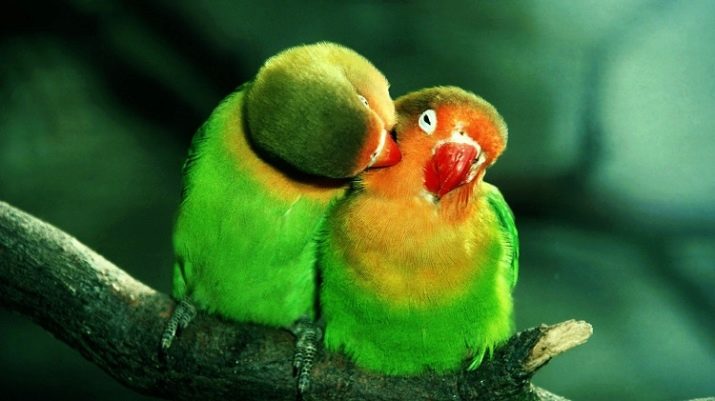
The parrot will speak loudly. This is a natural feature, and nothing can be done about it. You need to train him gradually. Long painstaking work will allow the bird to master up to 10 words. It is impossible to achieve more. It is important to understand: the development of human speech is a stressful mode for the bird. That is loneliness. Classes should be held every day, seven days a week, spending 40-45 minutes three times or four times a day. A parrot is trained to speak at the same time. Training begins at 7 or 8 months (and earlier and later it makes no sense).
It takes about 12 months to wait for the result. The first words should be with sounds A and O. Best of all, if the nickname of the lovebird also includes such phonemes. When choosing a name, you need to choose only short words that can be clearly pronounced.
Noticing the success of the animal, encourage him with a portion of goodies or stroking.
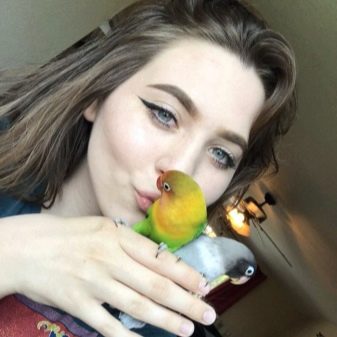

Features of care and breeding
Lovebirds can be kept at home quite calmly. However, the correct choice of an individual plays an important role. A healthy bird is different:
- smooth, sparkling plumage in the sun;
- the uniformity of the pen throughout the body;
- clear expression of the eyes;
- activity and curiosity.
For transporting birds use a transport cage. If it is not, you can use a box of plywood, in the upper part of which a hole is made. When delivering a parrot home in late autumn, winter or early spring, you need to use a bag. It reduces the likelihood of hypothermia. The best permanent artificial nests are made of nickel-plated steel along with plastic or plexiglass.
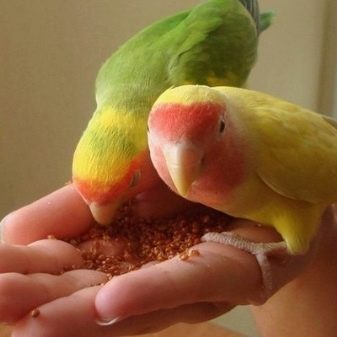
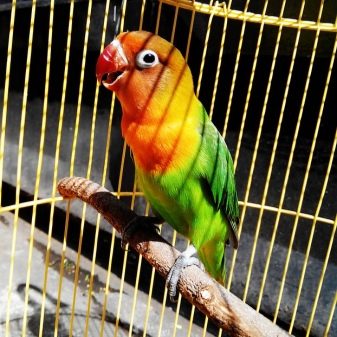
But it is better to refuse copper, zinc, lead, bamboo and wooden cages. Perfect shape - a rectangle with a flat roof. The space in the cage and the ability to push the bottom are very important. Between the rods should be 0.01-0.015 m. Since the birds come from a humid tropical zone, the air should be warmed up to 23-25 degrees with a relative humidity of 50 to 60%.
Do not settle lovebirds near hot batteries and heating equipment. It is necessary to ensure normal lighting in the room. The window is hung with a thin tulle to prevent direct sunlight from falling.
Strongly unacceptable drafts.
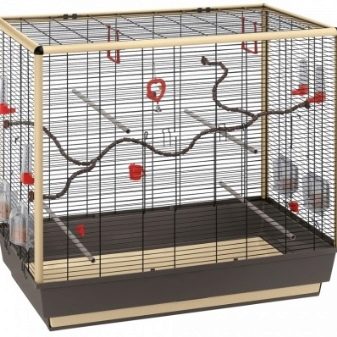

Mandatory requirements for a good cell are:
- a pair of feeders (separately for dry and wet food);
- automatic drinker;
- bath.
Dry food should be poured from the evening with the expectation until the end of the next day. Wet food is poured in the mornings, removed in the evenings. It is necessary to wash the feeders before each new tab. The whole cell is washed every 7 days with hot water without soap. At the same time, the litter is also being changed.
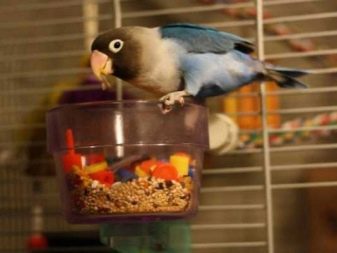
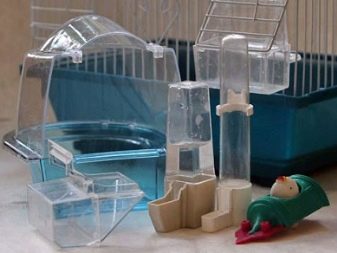
Grains and seeds dominate the diet. If there is no desire to purchase store food, lovebirds are fed (per day):
- 0.15 kg of millet;
- 0.15 kg of canary seeds;
- 0.2 kg of oatmeal;
- 0.1 kg of sunflower seeds;
- 0.1 kg of pure oats;
- 0.1 kg of coarse corn.
As a treat, periodically give crackers, nuts. Certainly apply succulent feed.
You can’t give parsley! It is necessary to find out in advance which indoor and field plants are dangerous for the bird.
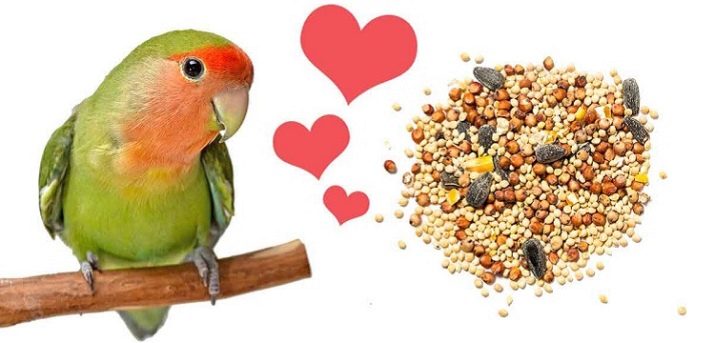
In the summer months, daily bathing should be done. During the breeding season, when birds hatch their eggs, as well as when the chicks have hatched, but have not yet matured, special care should be taken. The slightest mistake can lead to sad consequences. Excessive intrusion into personal space will harm parrots. There is no need to grind the beak. Instead of special tools, they simply give young branches of fruit trees.
The best time for breeding is summer and early autumn. Healthy chicks will be with air humidity from 50 to 60%. The temperature in this case is from 18 to 20 degrees. A nest house is put in a cage. A pair of parrots will give up to 8 chicks.

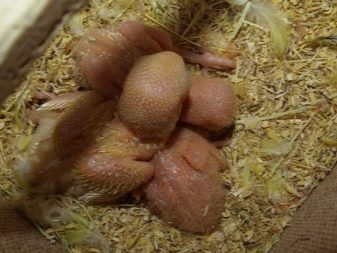
Host reviews
Single cultivation of lovebirds is more difficult than keeping couples. Lovebirds:
- are beautiful;
- quite sociable;
- cause inconvenience in a harsh voice;
- may litter while eating;
- severely limit the freedom of owners.
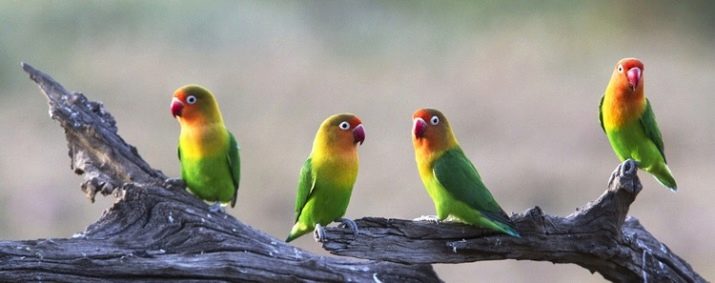
In the next video you will find even more information about lovebird parrots.
